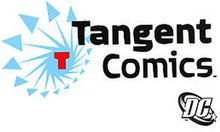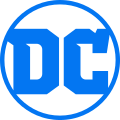
The Justice League, or Justice League of America (JLA), is a group of superheroes appearing in American comic books published by DC Comics. The team first appeared in The Brave and the Bold #28. The team was conceived by writer Gardner Fox as a revival of the Justice Society of America, a similar team from DC Comics from the 1940s which had been pulled out of print due to a decline in sales.

Dan Jurgens is an American comic book writer and artist. He is known for his work on the DC comic book storyline "The Death of Superman" and for creating characters such as Doomsday, Hank Henshaw, and Booster Gold. Jurgens had a lengthy run on the Superman comic books including The Adventures of Superman, Superman vol. 2 and Action Comics. At Marvel, Jurgens worked on series such as Captain America, The Sensational Spider-Man and was the writer on Thor for six years. He also had a brief run as writer and artist on Solar for Valiant Comics in 1995.
Ryan Sook is an American comic book artist, known for his work on books such as Seven Soldiers: Zatanna, X-Factor and The Spectre. His style has been compared to that of Mike Mignola, Adam Hughes, and Kevin Nowlan.
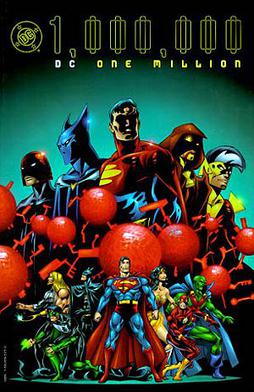
"DC One Million" is a comic book crossover storyline which ran through an eponymous weekly miniseries and through special issues of almost all of the "DCU" titles published by DC Comics in November 1998. It featured a vision of the DC Universe in the 853rd century, chosen because that is the century in which DC would have published issue #1,000,000 of Action Comics if it had maintained a regular monthly publishing schedule. The miniseries was written by Grant Morrison and drawn by Val Semeiks.

"Infinite Crisis" is a 2005–2006 comic book storyline published by DC Comics, consisting of an eponymous, seven-issue comic book limited series written by Geoff Johns and illustrated by Phil Jimenez, George Pérez, Ivan Reis, and Jerry Ordway, and a number of tie-in books. The main miniseries debuted in October 2005, and each issue was released with two variant covers: one by Pérez and one by Jim Lee and Sandra Hope.
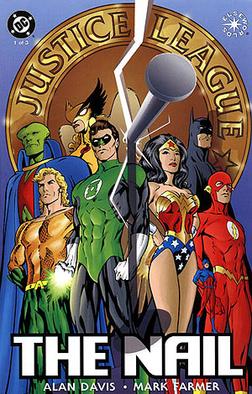
JLA: The Nail is a three-issue comic book mini-series published by DC Comics in 1998 under its Elseworlds imprint. The story, written and drawn by Alan Davis, is set in a parallel universe where Jonathan and Martha Kent's truck experiences a flat tire caused by a nail, which stops them from discovering a Kryptonian spaceship outside Smallville containing the baby Kal-El, negating Superman. It was later followed by a sequel, JLA: Another Nail, a three-issue mini-series published in 2004 which wrapped up several loose ends from the original mini-series, such as the war between the New Gods and the Green Lantern Corps and Oliver Queen's public betrayal of the Justice League.
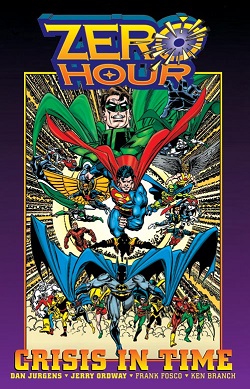
"Zero Hour: Crisis in Time!" is a comic book crossover storyline published by DC Comics in 1994, consisting of an eponymous five-issue limited series written and drawn by Dan Jurgens and a number of tie-in books.
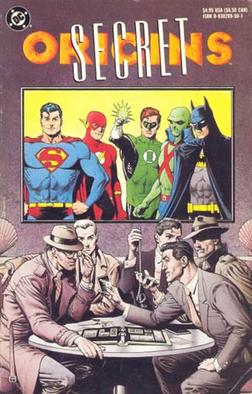
Secret Origins is the title of several comic book series published by DC Comics which featured the origin stories of the publisher's various characters.

Batman Total Justice is a line of toys produced by Kenner based on Batman and other, connected, DC Comics characters.

Justice is a twelve-issue American comic book limited series published bimonthly by DC Comics from August 2005 through June 2007, written by Alex Ross and Jim Krueger, with art also by Ross and Doug Braithwaite. Its story involves the superhero team known as the Justice League of America confronting the supervillain team the Legion of Doom after every supervillain is motivated by a shared dream that seems to be a vision of the planet's destruction, which they intend to avoid.
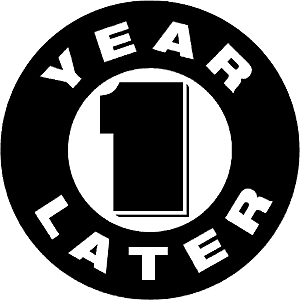
"One Year Later" is a 2006 comic book storyline running through the books published by DC Comics. As the title suggests, it involves a narrative jump exactly one year into the future of the DC Universe following the events of the “Infinite Crisis” storyline, to explore major changes within the continuities of the many different comic books within the DC Comics range.
DC Comics has produced many crossover stories combining characters from different series of comics. Some of these are set in the fictional DC Universe, or any number of settings within the DC Multiverse.

The Justice League, also called the Justice League of America or JLA, is a fictional superhero team that appears in comic books published by DC Comics. Since their first appearance in The Brave and the Bold #28, various incarnations of the team have appeared in film, television, and video game adaptations.
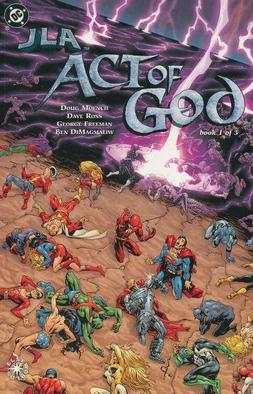
JLA: Act of God is a three issue limited series published by DC Comics under the Elseworlds banner in 2000. It is written by Doug Moench and illustrated by Dave Ross.
DC Universe: Justice League Unlimited Fan Collection is an action figure line based on the highly popular Justice League and Justice League Unlimited animated series. Though it was based on the show(s), the line has continued well beyond it, and has been re-branded in 2008, as a Target exclusive. Mattel announced in February 2011 that the line would come to an end later in the year with the final figures being released on the Mattel website including the final two three-packs, a seven-pack as well as the three exclusive Con three-packs being made available to the public.
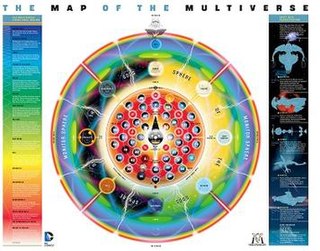
In most of the DC Comics media, the Multiverse is a "cosmic construct" composed of the many fictional universes the stories of DC media take place in. The worlds in the multiverse share a space and fate in common, and its structure has changed several times in the history of DC Comics.

DC Universe is a toy brand manufactured by Mattel. It has five sub-lines – Classics, Fighting Figures, Giants of Justice, Infinite Heroes, and the reintegrated Justice League Unlimited line.

Injustice: Gods Among Us is an American comic book series that serves as the prequel to the fighting video game of the same name. The series takes place in an alternate reality, where Superman descends into villainy following his family's death at the Joker's hands. The Justice League is split by those who put their trust in Superman, establishing the totalitarian One Earth Regime, while Batman forms an insurgency out of the other half of the League to fight back against the Regime.
